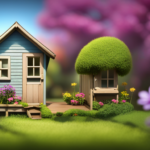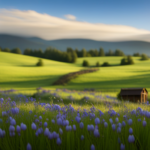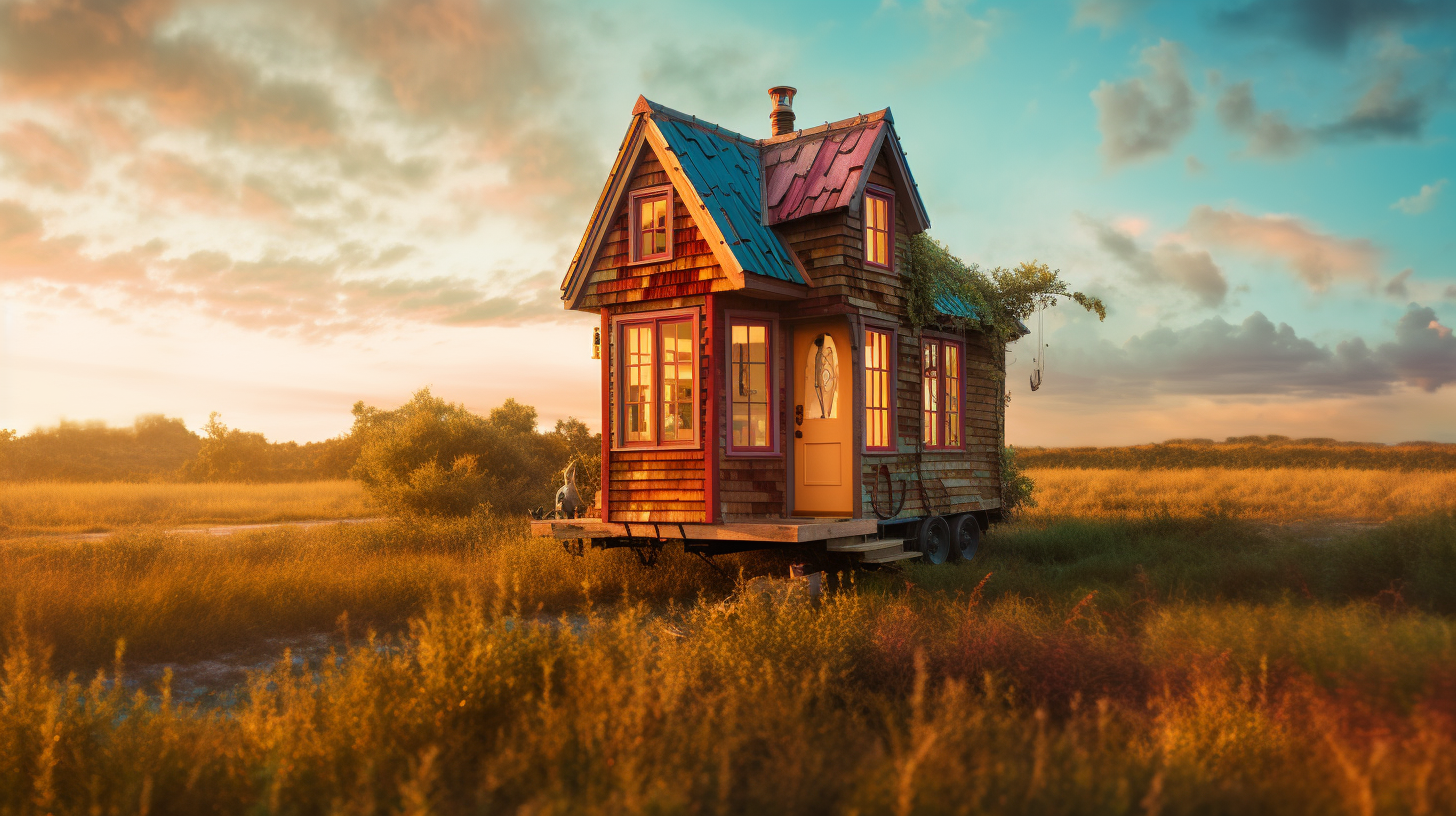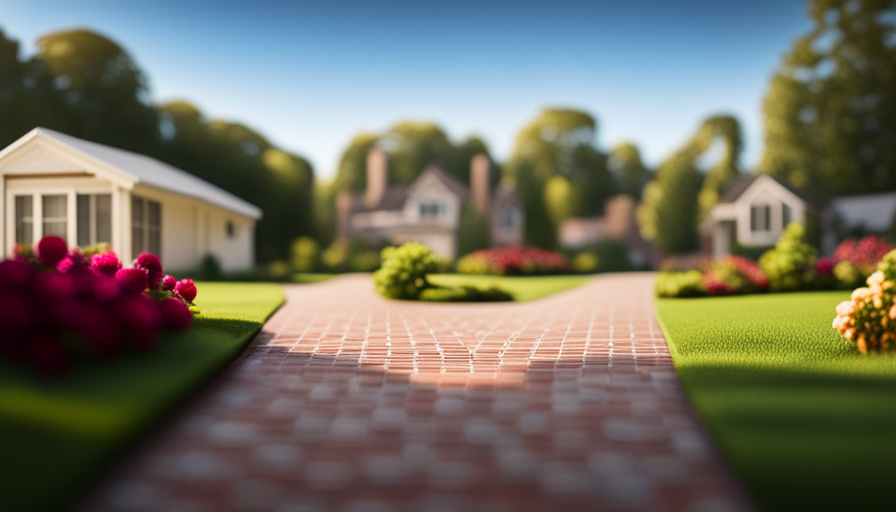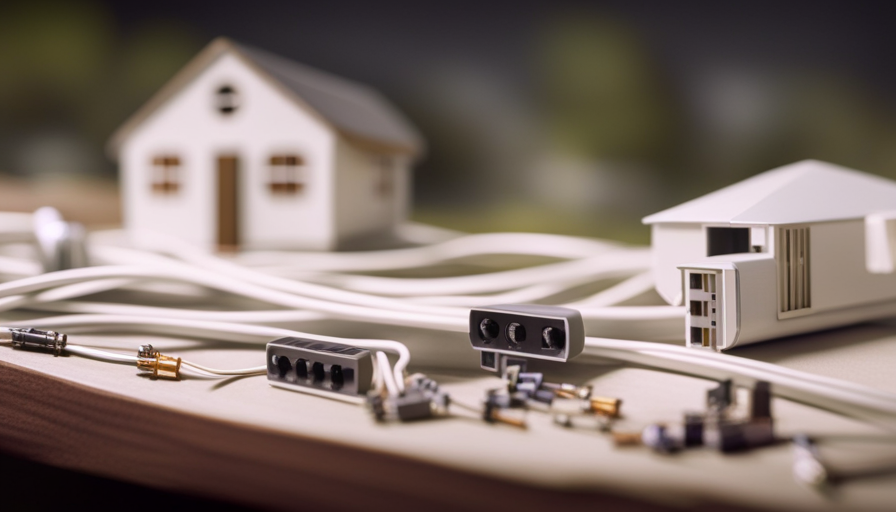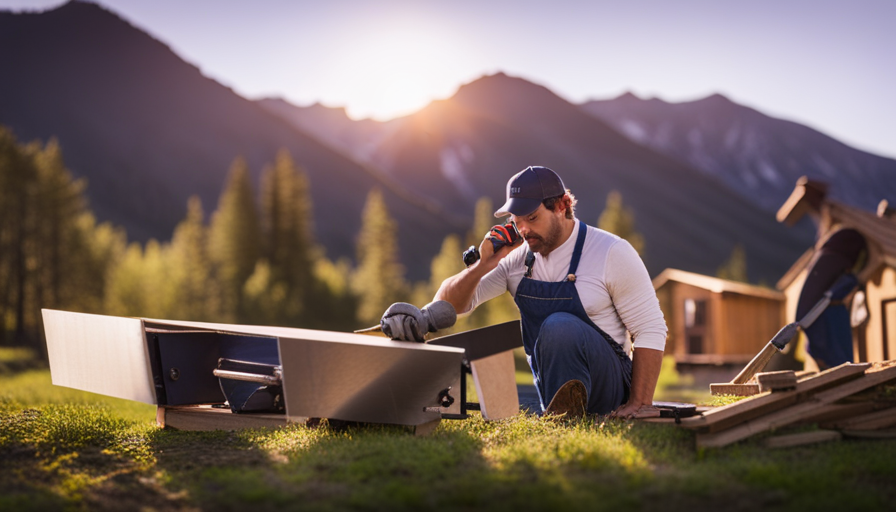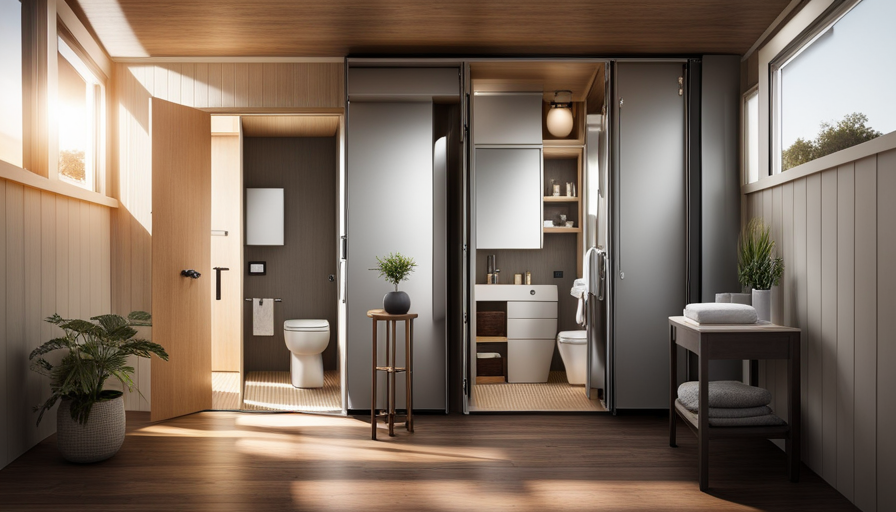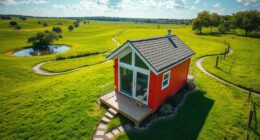In a world where the pressures to conform can feel overwhelming, stifling our dreams and limiting our potential, there are courageous individuals who dare to challenge the status quo. These individuals break free from societal expectations in search of a more fulfilling and meaningful life. The pages of this remarkable book reveal the inspiring story of a woman who defied the norm by building her own tiny home.
Like a phoenix rising from the ashes, this tale is a testament to the indomitable spirit within us all. It is a story of courage, determination, and the relentless pursuit of a life less ordinary.
From the initial spark of inspiration to the final brushstroke of her masterpiece, this woman’s story will captivate your heart and ignite a fire within your soul.
Join me as we delve into the intimate details of her transformation – the trials and tribulations, the triumphs and joys. Through her words, we will uncover the secrets of designing and planning a tiny house, overcoming obstacles, and embracing a life of simplicity.
So, open your mind, and prepare to be inspired by the extraordinary tale of a woman who built her dream, one tiny step at a time.
Key Takeaways
- The book focuses on a woman’s journey of building her own tiny house for a simpler and more sustainable lifestyle.
- The woman’s motivation is to prioritize what truly matters in life.
- The design and planning of the tiny house involve meticulous attention to detail, maximizing functionality and storage.
- The woman faces challenges such as financial constraints and zoning regulations, but ultimately benefits from financial freedom, a minimalist lifestyle, and a sense of calm and clarity.
The Inspiration Behind the Woman’s Decision to Build a Tiny House
Imagine waking up every morning in a cramped apartment, feeling suffocated by the walls closing in on you, until one day you stumble upon a captivating story about a woman who found freedom and liberation in building her own tiny house. As I read about her journey, I couldn’t help but be inspired by her determination and resilience.
The woman’s motivation to build a tiny house stemmed from her desire for a simpler, more sustainable lifestyle. She longed to break free from the clutches of societal expectations and embrace a life filled with purpose and meaning.
The impact on her lifestyle was profound. By downsizing to a tiny house, she discovered the true essence of minimalism. She realized that happiness doesn’t come from material possessions, but from experiences and connections. Living in a tiny house allowed her to focus on what truly mattered to her – spending quality time with loved ones, pursuing her passions, and exploring nature’s wonders.
Designing and planning the construction of the tiny house became her next adventure. With meticulous attention to detail, she crafted a space that wasn’t only functional but also reflected her unique personality and style. Every nook and cranny was thoughtfully designed to maximize storage and optimize living space.
The transition into the subsequent section about designing and planning the construction of the tiny house was an exciting step towards turning her dream into a reality.
Designing and Planning the Construction of the Tiny House
As I envision my dream abode, every detail of the meticulously crafted miniature dwelling comes to life, a reflection of my unique personality and style. Designing and planning the construction of my tiny house presented its fair share of challenges. The limited space required me to think creatively and make the most of every square inch.
One of the biggest designing challenges I faced was maximizing the functionality of the interior spaces. I wanted my tiny house to feel spacious and open, despite its small dimensions. To achieve this, I carefully considered the layout and placement of furniture, ensuring that every piece served a purpose and made the most efficient use of space.
To provide a visual representation of the thought and care put into the design, I’ve created a table below:
| Design Challenge | Solution | Result |
|---|---|---|
| Limited space | Multi-purpose furniture | Increased functionality |
| Storage | Clever built-in storage solutions | Reduced clutter |
| Natural light | Skylights and large windows | Bright and airy atmosphere |
Overcoming these challenges and obstacles during the building process was no easy feat. However, with determination and a creative mindset, I was able to turn my tiny house vision into a reality.
Overcoming Challenges and Obstacles During the Building Process
To successfully navigate the construction process of your dream abode, you’ll need to overcome various challenges and obstacles along the way. Building a tiny house is no exception. One of the most common challenges is overcoming financial constraints. Building a house, even a tiny one, requires a significant investment of time and money. However, with careful planning and budgeting, it’s possible to build your dream tiny house without breaking the bank.
There are many cost-saving strategies, such as sourcing reclaimed materials, repurposing furniture, and even seeking out sponsorship or crowdfunding opportunities. By thinking outside the box and being resourceful, you can overcome financial obstacles and turn your dream into a reality.
Another obstacle to consider is dealing with zoning regulations. Depending on where you plan to build your tiny house, you may encounter restrictions and regulations that can complicate the construction process. It’s crucial to research and understand the zoning laws in your area before starting the project. This’ll help you avoid any legal issues and ensure that your tiny house meets all necessary requirements. It may require obtaining permits or making modifications to comply with local regulations. However, with determination and persistence, you can navigate these challenges and move forward with your construction plans.
Overcoming financial constraints and dealing with zoning regulations are just two of the many challenges you may face while building your tiny house. However, with careful planning and a positive mindset, you can overcome these obstacles and continue on your journey to creating your perfect tiny home.
In the next section, we’ll explore the benefits of living in a tiny house, highlighting how it can enhance your life in numerous ways.
The Benefits of Living in a Tiny House
Living in a small dwelling can bring immense joy and fulfillment, offering a sense of freedom and simplicity that is truly priceless. When I made the decision to build my own tiny house, I was drawn to the idea of financial freedom and a minimalist lifestyle. Now that I am settled into my cozy abode, I can confidently say that the benefits of living in a tiny house far outweigh any sacrifices I had to make during the building process.
One of the greatest advantages of living in a tiny house is the financial freedom it provides. With a smaller mortgage or no mortgage at all, I have more disposable income to pursue my passions and enjoy life to the fullest. I am no longer burdened by excessive bills and can focus on experiences and personal growth.
Furthermore, the minimalist lifestyle that comes with living in a tiny house has transformed my perspective on material possessions. I have learned to cherish the things that truly matter and let go of unnecessary clutter. This newfound simplicity has brought a sense of calm and clarity to my life.
Living in a tiny house has allowed me to create a functional and stylish interior space that reflects my personality and values. In the next section, I will share how I utilized creative design techniques to make the most of my limited square footage.
Creating Functional and Stylish Interior Spaces
Designing a small space can be a challenge, but with clever strategies, it becomes a thrilling opportunity to create a functional and stylish interior. In a tiny house, every square inch counts, so it’s essential to make the most of the available space.
One of the key elements in creating a functional interior is incorporating functional storage solutions. From hidden compartments in the stairs to multipurpose furniture with built-in storage compartments, there are plenty of creative ways to maximize storage in a tiny house.
Another aspect to consider is the creative use of space. With limited square footage, it’s important to think outside the box and utilize every nook and cranny. For example, installing floating shelves on the walls can provide additional storage without taking up valuable floor space. Additionally, using furniture that serves multiple purposes, such as a sofa that can be transformed into a bed, allows for flexibility and makes the most of the available space.
By combining functional storage solutions and creative use of space, a tiny house can be transformed into a stylish and efficient home. As we delve into the next section about the sustainable and eco-friendly features of the tiny house, it’s important to remember that even in a small space, functionality and style can go hand in hand.
Sustainable and Eco-Friendly Features of the Tiny House
Incorporating sustainable and eco-friendly features into the design of a small dwelling can not only minimize its environmental impact but also create a healthier and more efficient living space. When building my tiny house, I focused on integrating energy efficient technology and water conservation methods, ensuring that my home was not only cozy but also environmentally responsible.
One of the key features I implemented was solar panels, which harness the power of the sun to generate electricity. These panels not only reduce my reliance on traditional energy sources, but also help me save money on utility bills. Additionally, I installed LED lights throughout the house, which consume less energy compared to traditional incandescent bulbs.
To conserve water, I installed low-flow faucets and showerheads, as well as a composting toilet system. These measures not only reduce water consumption but also minimize the strain on local water resources. Furthermore, I collect rainwater in a barrel and use it for watering plants and cleaning purposes.
By incorporating these sustainable features, my tiny house not only operates efficiently but also promotes a more eco-friendly lifestyle. Transitioning to a smaller living space has allowed me to embrace a simpler way of life, which I will delve into further in the next section, where I will share tips and tricks for downsizing and simplifying your life.
Tips and Tricks for Downsizing and Simplifying Your Life
As I explored the sustainable and eco-friendly features of the tiny house, I couldn’t help but feel inspired to make changes in my own life. Downsizing and simplifying seemed like the logical next step towards creating a more mindful and intentional lifestyle.
So, I embarked on a journey to discover tips and tricks for organizing and decluttering, eager to bring a sense of order and calmness into my space.
Here are five items that resonated with me on my quest for simplicity:
- Embrace minimalism: Let go of items that no longer serve a purpose or bring you joy.
- Create designated spaces: Assign specific areas for different categories of belongings, making it easier to find and put away items.
- Adopt a one-in-one-out rule: For every new item you bring into your home, let go of something else to maintain balance.
- Utilize vertical storage: Maximize your space by using shelves, hooks, and hanging organizers to keep things off the floor.
- Practice regular decluttering: Set aside time each month to reevaluate your belongings and let go of anything that no longer aligns with your values.
With these tips in mind, I began my journey towards a more streamlined existence, eager to see the positive impact it would have on my life.
Little did I know that this process of decluttering and simplifying was just the beginning of my own personal transformation through the tiny house experience.
The Woman’s Personal Journey and Transformation Through the Tiny House Experience
Through her journey in the small abode, she found herself shedding the unnecessary weight of material possessions and blossoming into a more mindful and intentional version of herself. Living in a tiny house forced her to confront her attachment to material things and reassess what truly mattered in her life. As she let go of the excess, she discovered a newfound sense of freedom and liberation.
In the table below, I have highlighted some key moments in her personal growth and self-discovery journey:
| Personal Growth | Self-Discovery |
|---|---|
| Letting go of clutter | Finding inner peace |
| Simplifying her life | Embracing minimalism |
| Developing mindfulness | Cultivating gratitude |
| Prioritizing experiences | Appreciating simplicity |
Through the process of downsizing and simplifying, she learned to appreciate the beauty in simplicity and the joy that comes from experiences, rather than material possessions. She realized that the size of her house did not define her, but rather the depth of her connections, the richness of her experiences, and the growth she achieved along the way.
In the end, her tiny house became a symbol of her personal growth and self-discovery. It served as a reminder of the transformative power of letting go and embracing a more intentional way of living. Through her journey, she not only built a tiny house, but she also built a stronger and more authentic version of herself.
Frequently Asked Questions
How much did it cost to build the tiny house?
Building my tiny house was a budget-friendly adventure. With a cost breakdown, I managed to build it for $20,000. Here are some tips for keeping construction costs low: repurpose materials, use energy-efficient appliances, and DIY as much as possible.
What materials were used in the construction of the tiny house?
In constructing my tiny house, I employed sustainable building practices, carefully choosing materials that minimized environmental impact. From reclaimed wood for the siding to energy-efficient windows, I ensured every interior design choice aligned with my eco-friendly vision.
How long did it take to build the tiny house?
It took me several months to build the tiny house, utilizing various construction techniques. The timeline was filled with excitement and challenges as I carefully crafted each detail, turning my vision into a cozy and sustainable home.
Did the woman encounter any legal issues or zoning restrictions while building the tiny house?
Yes, I encountered numerous legal challenges and zoning restrictions while building my tiny house. Navigating the red tape was like a maze, but I persevered, finding creative solutions and pushing boundaries along the way.
How did the woman handle the challenges of living in a small space, such as storage and organization?
Living in a small space was like playing a never-ending game of Tetris. I had to become a master of storage solutions, maximizing every inch. From hidden compartments to hanging organizers, I turned my tiny house into a storage wonderland.
Conclusion
In the end, as I stand here in my tiny house, I’m reminded of the power of dreams. Through the challenges and triumphs, I’ve built not just a physical structure, but a sanctuary for my soul.
This journey has taught me the art of simplicity, the beauty of sustainable living, and the joy of embracing a smaller footprint. As I navigate through life in my tiny haven, I’m reminded that sometimes, the biggest transformations come from the smallest spaces.
Hi, I’m Emma. I’m the Editor in Chief of Tiny House 43, a blog all about tiny houses. While tree houses are often associated with childhood, they can be the perfect adult retreat. They offer a cozy space to relax and unwind, surrounded by nature. And since they’re typically built on stilts or raised platforms, they offer stunning views that traditional homes simply can’t match. If you’re looking for a unique and romantic getaway, a tree house tiny house might just be the perfect option.



